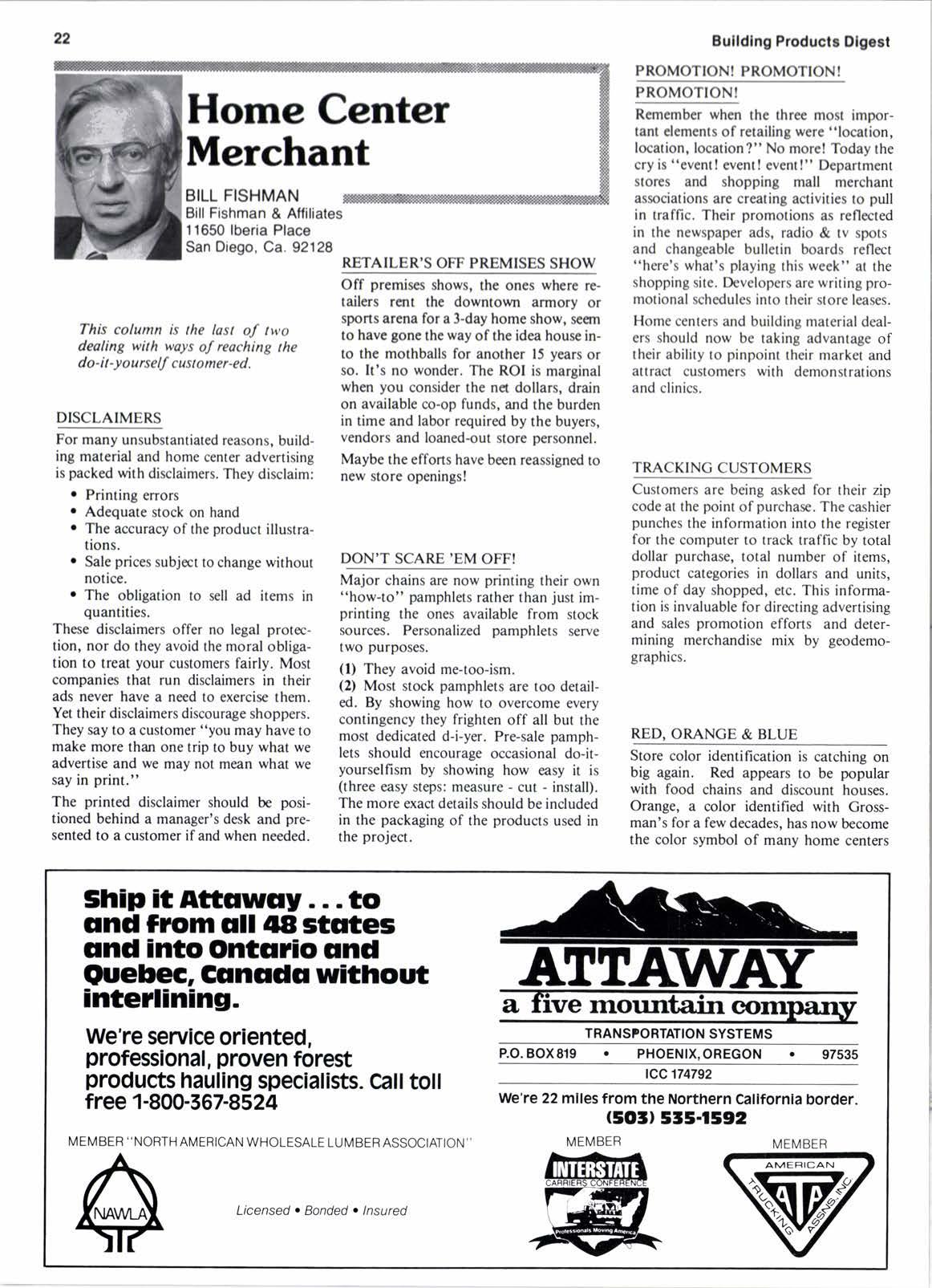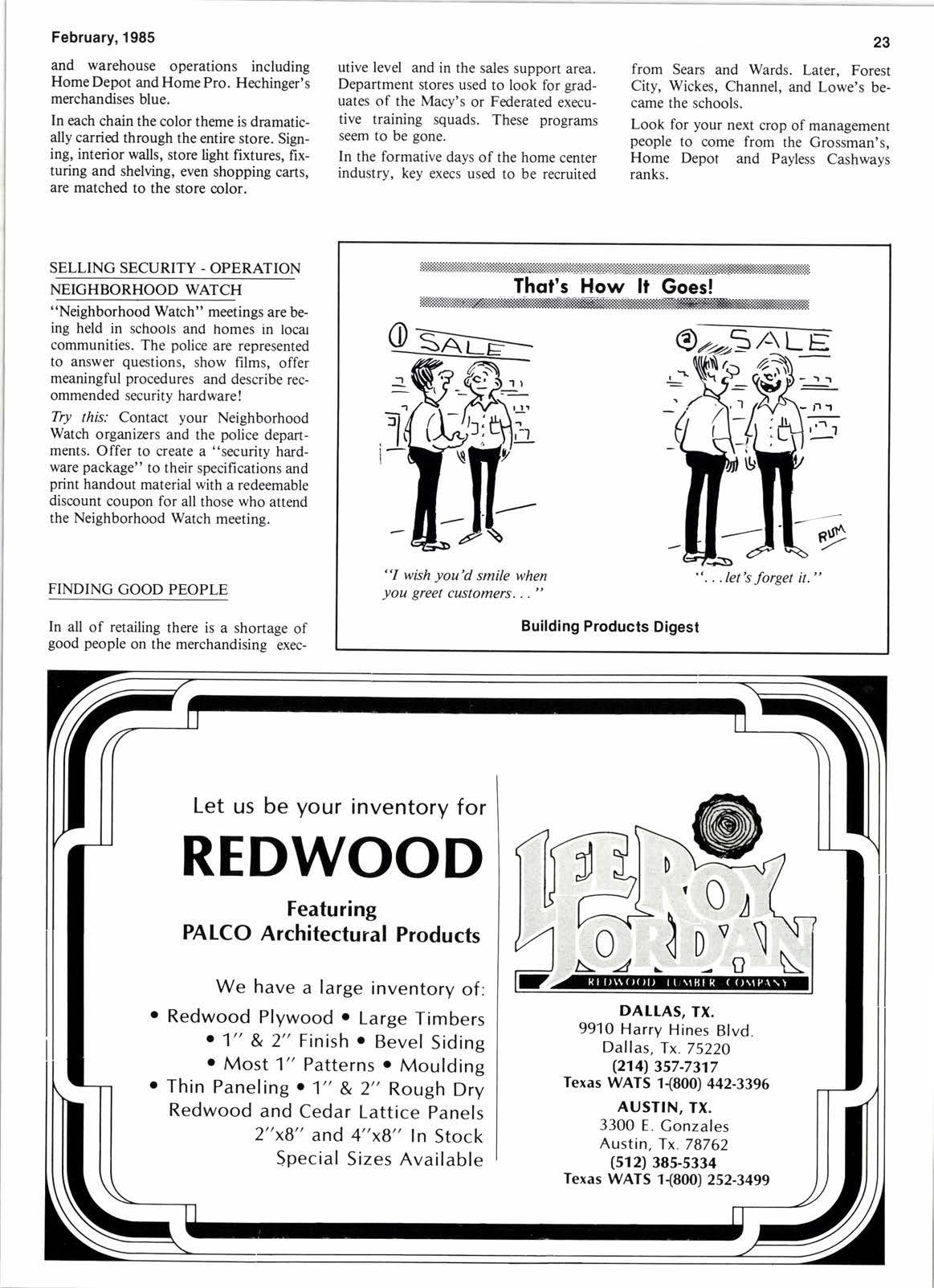
3 minute read
HomeCenter Merchant
Bill Fishman
Bill Fishman & Atliliates
11650 lberia Place
San Diego, Ca.92128
RETAILER'S OFF PREMISES SHOW
Disclaimers
For many unsubstantiated reasons, building material and home center advertising is packed with disclaimers. They disclaim: o Printing enors o Adequate stock on hand o The accuracy of the product illustrations. o Sale prices subjct to change without notice. o The obligation to sell ad items in quantities.
These disclaimers offer no legal protection, nor do they avoid the moral obligation to treat your customers fairly. Most companies that run disclaimers in their ads never have a need to exercir them, Yet their disclaimers discourage shoppers. They say to a customer "you may have to make more than one trip to buy what we advertise and we may not mean what we say in print."
The printed disclaimer should be positioned behind a manager's desk and presented to a customer if and when needed.
Off premises shows, the ones where retailers rcnt the downtown armory or sports arena for a 3-day home show, scanr to have gone the way of the idea house into the mothballs for another 15 years or so. lt's no wonder. The ROI is marginal when you consider the nd dollars, drain on available co-op funds, and the burden in time and labor required by the buyers, vendors and loaned-out store personnel. Maybe the efforts have been reassigned to new store openings!
Rcmember when the three most important elements of retailing were "location, location, Iocation?" No more! Today the cry is "event! event! event!" D€partment stores and shopping mall merchant associations are creating activities to pull in traffic. Their promotions as reflected in the newspaper ads, radio & tv spots and changeable bulletin boards reflect "here's what's playing this week" at the shopping site. Developers are writing promotional schedules into their store leases. Home centers and building material dealers should now be taking advantage of their ability to pinpoint their market and attracl customers with demonstrations and clinics.
DON'T SCARE'EM OFF!
Major chains are now printing their own "how-to" pamphlets rather than just imprinting the ones available from stock sources. Personalized pamphlets serve two purposes.
(l) They avoid me-too-ism.
(2) Most stock pamphlets are too detailed. By showing how to overcome every contingency they frighten off all but the most dedicated d-i-yer. Pre-sale pamphlets should encourage occasional do-ityourselfism by showing how easy it is (three easy steps: measure - cut - install). The more exact details should be included in the packaging of the products used in the project.
Tracking Customers
Customers are being asked for their zip code at the point of purchase. The cashier punches the information into the register for the computer to track traffic by total dollar purchase, total number of items, product categories in dollars and units, time of day shopped, etc. This information is invaluable for directing advertising and sales promotion efforts and determining merchandise mix by geodemographics.
RED, ORANGE & BLUE
Store color identification is catching on big again. Red appears to be popular with food chains and discount houses. Orange, a color identified with Grossman's for a few decades, has now become the color symbol of many home centers and warehouse operations including Home Depot and Home Pro. Hechinger's merchandises blue.
In each chain the color theme is dramatically carried through the entire store. Signing, interior walls, store light fixtures, fixturing and shelving, even shopping carts, are matched to the store color.
Selw
W"Neighborhood Watch" meetings are being held in schools and homes in locar communities. The police are represented to answer questions, show films, offer meaningful procedures and describe recommended security hardware!
Try this: Contact your Neighborhood Watch organizers and the police departments. Offer to create a "security hardware package" to their specifications and print handout material with a redeemable discount coupon for all those who attend the Neighborhood Watch meeting.

utive level and in the sales support area. Department stores used to look for graduates of the Macy's or Federated executive training squads. These programs seem to be gone.
In the formative days of the home center industry, key execs used to be recruited from Sears and Wards. Later, Forest City, Wickes, Channel, and Lowe's became the schools.
Look for your next crop of management people to come from the Crossman's, Home Depot and Payless Cashways ranks.
Finding Good People
In all of retailing there is a shortage of good people on the merchandising exec-
Building Products Digest












